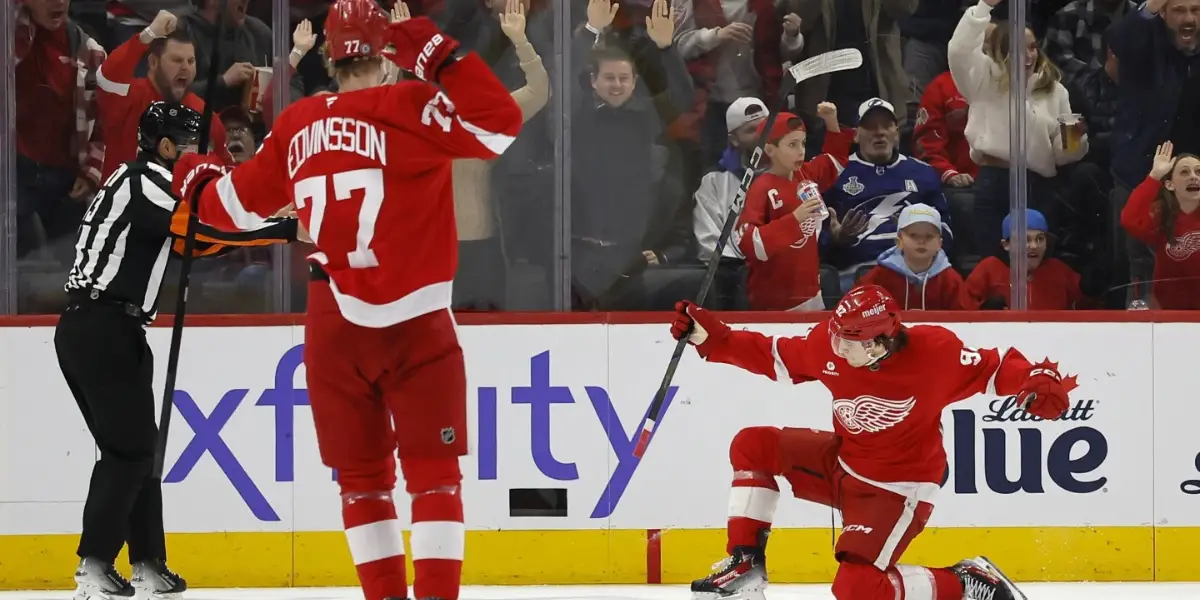
Detroit still has a major need at top six forward. Last season, they had the same problem, except they also had a questionable second-line center in J.T. Compher. After the Tarasenko experiment bombed and Compher took a leap back, Detroit needed two top-six forwards, and they likely found a big one in Marco Kasper. The 2022 draftee played fantastically in his rookie season. 19 goals, 18 assists for 37 points, as well as 156 hits, Kasper is giving Red Wings fans the hope that they have the second line center of the future. I’ll go over plenty about Kasper today and outline what the coming season might look like for him.
Offense:
Role, 2C/1LW: Kasper’s role is largely the same no matter where he plays. While the center responsibilities are inherently tougher than wing duties, Kasper has functionally the same job during play. On both lines, Kasper is F1 (the first forechecker), his job is to bang and crash until he gets his line the puck. I’ve seen screenshots mentioning Kasper has gotten up to 200lbs. If he can throw those around while still skating well, he should excel as F1.
Location, left flank/net front: Without possession, Kasper is effective at laying hits and stick checking to get his team the puck. He will be on the boards and the deepest forward behind the net. With possession, his role changes depending on the line. On the first line, Larkin prefers to be in the bumper position and Raymond on the right flank. Naturally, Kasper is left flank and will rotate net front for rebounds or screens as he is the only one on the top line physical enough to do so. On the second line center, Kasper will be net front. Kane and DeBrincat play the flanks well, and Kasper will be down low to help either of them on their side and create rebound chances.
Pros: physical game and retrieval. Kasper is imposing physically and can cut down on opponents quickly with good speed. It’s his primary trait. 156 hits as well as his skating being a plus, he has 160 splits over 20mph. He uses his size to get close to the net where he generates most of his chances. Kasper is already in the 87th percentile for offence (per JFresh’s Hockey Cards), and he is able to generate high danger chances well.
Cons: finishing and playmaking. That might seem misleading, but Kasper’s shot is quite hard, and he’s shown flashes of being a quality sniper. His shot is at average 54.2MPH, which seems low, but a lot of his chances are from less than 10 feet out, there’s not a lot of time to get power shots. Generally, though, his xG would suggest he should be burying in tight more. His finishing percentile is down around 57% which should be higher on a 2C, it will likely improve with time though. While a competent playmaker, it’s not a strength, 15% percentile in first assists isn’t ideal. While Kasper is a complementary forward and a great one at that, Kasper could use some improvements with the puck on his stick.
Eye Test: Kasper is aggressive and physical, and his play echoes Sam Bennet. The low finishing does surprise me a little. His shot seems both accurate and able to catch goalies off guard. Between DeBrincat and Kane, Kasper looked better in the sheltered role, which is likely where he will stay. Kasper understands his role; dig the puck out for the stars and get close to the crease, and is effective as such. Under McClellan, where Kasper was in the top 6, he was on a 50 55-point pace. With a full season in a big role, he should be able to contribute around that level. On the power play I see him play the flank more than the bumper, using his hard shot. Kasper does pretty standard on the power play. With the extra space, he knows when to rip a shot and when to move the puck. His 35% power play percentile needs to improve if he wants to raise his numbers. Despite being on the second unit, the power play is still very effectiv,e and I’d like to see him take advantage of the open space and get closer to the net. His 67.3% individual points percentage highlights the biggest desire with Kasper, he does pretty much everything right, he just doesn’t stuff the stat sheet as much as he probably should. In an increased role and another season of development under his belt, Kasper should be able to round out his game in all areas and surprise people with the steps he takes.
Prediction: I could see Kasper pretty easily netting 25 goals, only six more than he had, not to mention Kasper spent plenty of time in a really bad bottom 6. Adding 6 to his goal total seems fine. As for assists, they will come easier for him, but they’re likely to be secondary. I still think around 30 assists is possible, give or take 5 in either direction. Personal prediction; 82GP 27G 33A 60P.
Defense:
Role, 2C/1LW: No matter where Kasper ends up in the lineup, pressure is on. He may have to take on elite competition with Larkin and Raymond in some of the league’s hardest deployments. The top line would pit Kasper against 54% defensive deployments against 99th percentile competition, but Larkin and Raymond are both good defensively. Larkin has a 72% percentile defense against 98% percentile competition, and Raymond has a 66% percentile defense against 99% percentile competition. If Kasper is on the second line center, the pressure eases a lot. Kasper would face 46% defensive starts against +0.1 competition. However, he would be the sole defender on the line. DeBrincat has a 25% defensive percentile against 74% percentile competition, while Kane has 5% defensive percentile against 64% competition. Both players on the second line aren’t physical either, so Kasper would be doing the dirty work. Kasper should be able to hold water on either line, his 73% percentile defence against 70% percentile competition can work with both lines. Larkin and Raymond will either insulate him enough against higher competition, where he fits in, and the easier competition DeBrincat and Kane play should allow him to carry the defensive side adequately.
Location, strong-side forward/pressure forward: Another one that is highly dependent on who he is playing with. On the top line, Kasper will continue to be the strong-side defender. Kasper’s size and physicality worked well checking along the boards and forcing turnovers. With Larkin and Raymond on his line, his tidy stick work should help generate breakout chances. On the second line, Kasper has to play a pressure forward. I’m a little foggy here, but from what I remember, Kane and DeBrincat were used as slot protectors and helped get kick passes on the boards. I believe Kasper was the pressure forward. Kasper was kind of everywhere the puck was, using his size and speed to pressure skaters towards the boards. Pressure forward is inherently the harder role, even more so when his support isn’t good along the boards. However, Kasper’s style caters better to pressure forward. He should be a plus no matter which line.
Pros, physicality and defensive IQ: Kasper is already a fairly complete defender. He’s able to cover pretty much any skater on the opposing team well and disrupt with well-timed stick checks. Kasper has no worries closing out along the boards and finishing his checks. Kasper knows when to carry the puck and when to pass it. He is great physically in terms of speed and endurance as well, and is able to last long defensive shifts without too much trouble.
Cons, rush defence: It’s hard to pick a real con, Kasper is genuinely already a plus NHL defender. If I had to pick one, it feels like Kasper struggles getting set after zone entries. There have been some cases where his back check is either too slow or puts pressure on the wrong player, but that is few and far between. Generally, getting set a hair faster might help, but that’s grasping at straws. I picked something fairly universal here because a lot of players can improve on it, but I really don’t have complaints about Kasper defensively.
Eye Test: I’ve alluded to it a few times, but Kasper is genuinely a fantastic defensive forward. You spend more time trying to find a flaw than you do noticing one effect on the game. I believe that in either defensive role, he will fill out well. It’s hard to quantify defence, but you can clearly tell Kasper’s shut-down game is elite.
Prediction: Kasper will continue to be a great defender. Predicting defence is hard because there isn’t really a tangible way to do it. If you want to stick with the JFresh percentiles I’m using, I think he could reach the 80th percentile next season or at least the 75th. His defensive game has the highest floor of his toolset, though. Even at its worst, it will still be the second-best of the five bolt-on top-six forwards.
Special Teams:
Power Play, PP2 Flank: The couch-coach in me wants Kasper playing bumper or net front, but he is an effective flank. Kasper is used for his accurate and hard shot on the power play. I do think that with Soderblom, JVR, and Berggren getting a role, Kasper will end up getting pushed into a bumper. The Swedes are best as flanks, and JVR is pretty much a staple net front. Bumper will help Kasper if he plays there, as it puts him near the net. If he remains on the flank, his playmaking could use a step to increase his production. Power play 2 is tricky when power play 1 is expected to be great and handle most of the scoring. Kasper’s 4 points is objectively fine on the power play given its role. I think J.T. Compher’s 9 power play points is a good benchmark for Kasper to aim for.
Penalty Kill, PK3 slot protector: If I’m doing it in my head, Copp and Rasmussen are unit one, Appleton and Compher are unit two, so Larkin and Kasper would be unit three. Kasper may not see penalty kill at all because Detroit typically deploys DeBrincat after, and Kasper centering the line is crucial. I also wouldn’t be surprised if Larkin is off the penalty kill to ease his minutes a bit, in which case Kasper would play with a revolving door. Generally, if he is with Larkin, he would play as a slot protector on the boards and try to force the play up to Larkin at pressure forward. I’d like to see Kasper on the kill, but it’s not a huge difference maker as it stands either way.
That concludes my Kasper season preview. JFresh and Dobber Frozen Tools and the amazing work they do are my sources for this one. If this is something you’re interested in, you can drop a player you want to see in the comments down below. As always, thank you for reading.
More to Read:

ITR 49: For Real This Time – Inside The Rink
Discover more from Inside The Rink
Subscribe to get the latest posts sent to your email.



